The ringed seal (Pusa hispida)
The ringed seal (Pusa hispida) is an earless seal inhabiting the Arctic and sub-Arctic regions. The ringed seal is a relatively small seal, rarely greater than 1.5 m in length, with a distinctive patterning of dark spots surrounded by light gray rings, hence its common name. It is the most abundant and wide-ranging ice seal in the Northern Hemisphere, ranging throughout the Arctic Ocean, into the Bering Sea and Okhotsk Sea as far south as the northern coast of Japan in the Pacific and throughout the North Atlantic coasts of Greenland and Scandinavia as far south as Newfoundland, and including two freshwater subspecies in northern Europe. Ringed seals are one of the primary prey of polar bears and killer whales, and have long been a component of the diet of indigenous people of the Arctic.
Ringed seals are the smallest and most abundant member of the seal family that live in the Arctic and Sub-Arctic regions. The average life span of a ringed seal is 40 years, with a diet based mainly on Arctic cod and planktonic crustaceans. Typically about 1.5 metres (5 ft) long, the ringed seal is known to be solitary with their main predator being polar bears. Recently, however, the biggest threat to ringed seals has been the changing temperature in the Arctic and the detrimental changes to sea ice that follow. With declines in snowpack and sea ice due to warming ocean and atmospheric temperatures, survival has become tougher for ringed seals in the Arctic and Sub-Arctic regions. Yet ringed seals are also potentially projected to thrive due to warming, considering the early extinction of their predators.
Habitat
Pusa hispida is a species of pinniped mammal of the phocidae family (Phocidae).
Pusa hispida is the most common species of harbour seal in the Arctic: according to a conservative estimate, there are about 4 million ringed seals in the world. The seal is named for its fur pattern, which consists of a large number of light rings on a dark background.
Pusa hispida is distributed in the seas of the Arctic Ocean from the Barents Sea and the White Sea in the west to the Bering Sea in the east, also living in the Sea of Okhotsk and the Baltic Sea, the Tatar Strait, the Gulf of Finland and Lake Ladoga, sometimes reaching as far as St. Petersburg along the Neva River. Pusa hispida inhabits both the coastal zone and the open ocean, but more often stays in bays, straits and river mouths. This species does not regularly migrate on a large scale. During the winter, the seal inhabits the ice.
Appearance and nutrition
Pusa hispida is one of the smallest seals, with an adult body length of 1.5 m and a weight of 40-80 kg; some Baltic seals are even larger: 140 cm and 100 kg. Males are usually slightly larger than females. The body of the hispida is short and stout, the head is small, the snout is slightly flattened and the neck is so short and thick that it does not seem to exist. Pusa hispida have excellent eyesight, hearing and smell, which help them find food and hide from predators. Pusa hispida feed on crustaceans, molluscs and fish (spiny goby, Greenland goby, pike, saffron cod, salmon and salmon).
Life history
Pusa hispida never form colonies. They are usually solitary, although they sometimes gather in small groups, which are not very stable. They spend the whole year at sea, for which their body is very well adapted.
In summer, Pusas hispidas prefer to stay in coastal waters and occasionally form small shelters on stones or pebble spikes. In autumn, when the sea freezes over, most of the animals leave the coastal zone for deeper waters and drift on the ice.
A smaller proportion stay close to the coast during the winter, and remain in bays and coves. In this case, even at the beginning of the sea freeze the seal makes holes in the young ice, through which it emerges from the water. There are also smaller holes that are used only for breathing through. Often the hole is covered by a thick layer of snow, in which Pusa hispida makes a burrow with no exit hole to the outside. In such a comfortable place it rests, being invisible to its enemies, mainly polar bears.
The largest aggregations of Pusa hispida are observed in spring on drift ice during calving, moulting and mating. This is especially true in the seas of the Far East, where many hundreds, sometimes thousands of animals can be seen during a single day of ice drifting. Pusa hispida are most often found in groups of 10 to 20 animals, but sometimes there are groups of a hundred or more.
Reproduction
Pusa hispida mate in April or May and have a gestation period of 11 months, including a latency period of three months. In March/April of the following year, females give birth to a large calf 50-60 cm long and weighing about 4 kg. It is covered with a beautiful, thick white coat that lasts only a month and a half, being replaced by an ordinary grey coat, through which the characteristic rings of the species can be seen.
The "mother-to-be" prepares carefully for her young: she builds a shelter among the snow hummocks, the entrance to which is under water, so that the newborn is inaccessible to predators. For about two months the calf lives in its den, fed on its mother's milk. At the same time, the female goes hunting every day.
Females reach sexual maturity at four years and males at 5-7 years. The life expectancy of Pusa hispida is about 40 years.
Taxonomy and phylogeny
The taxonomy of ringed seal has been much debated and revised in the literature. Due to its wide range, as many as ten subspecies have been described. Currently, five distinct subspecies are recognized: Pusa hispida hispida in the Arctic Ocean and Bering Sea, Pusa hispida ochotensis in the Sea of Okhotsk, Pusa hispida saimensis in Lake Saimaa in Finland, Pusa hispida ladogensis in nearby Lake Ladoga in Russia and Pusa hispida botnica in the Gulf of Bothnia. The ringed seal is most closely related to the Caspian seal (Pusa caspica) and Baikal seal (Pusa sibirica), all of which share similar small sizes, features of skull morphology and affinity for ice.
The closest phylogenetic relatives to the genus Pusa are the grey seal (Halichoerus grypus) and the species in the genus Phoca (the harbor seal and largha seal), in which ringed seals were formerly classified. Together with the remaining northern latitude ice seals (ribbon seal, bearded seal, harp seal and hooded seal), these seals constitute the subfamily Phocinae.
Subspecies
- Pusa hispida hispida - Arctic coasts of Europe, Russia, Canada and Alaska, including New Zealand, Svalbard, Greenland and Baffin Island.
- Pusa hispida ochotensis - Kamchatka, Sea of Okhotsk and southwards to 35° N latitude, along the Pacific coast of Japan.
- Pusa hispida botnica - Inhabits the Baltic Sea, mainly in the Bay of Bothnia where there is a large population, but there are also endangered populations in the Gulf of Finland, the Gulf of Riga and the Archipelago Sea.
- Pusa hispida ladogensis (Ladoga seal) - Lake Ladoga.
- Pusa hispida saimensis (Saimaa ringed seal). - inhabits only Lake Saimaa in Finland and is one of the most endangered seals in the world, with a total population of no more than 380 individuals.
Life history
Females reach sexual maturity at 4 years while males do not reach maturity until 7 years old. During the spring breeding season, females construct lairs within the thick ice and give birth in these structures. Females give birth to a single pup on ice floes or shorefast ice in March or April after a 9-month gestation period. Pups are weaned after one month and build up a thick layer of blubber.
Females usually begin mating in late April. Males will roam the ice for a mate. When found, the male and female may spend several days together before mating. Then the male looks for another mate.
Ringed seals live about 25 to 30 years. They are solitary animals and when hauled out on ice separate themselves from each other by hundreds of yards.
Predators
Ringed seal are an important food item in particular for polar bears. During the pupping season, Arctic fox and glaucous gulls take ringed seal pups born outside lairs while killer whales, Greenland sharks and occasionally Atlantic walruses prey upon them in the water.
Human interactions
Ringed seals have long been an important component of the diet of Arctic indigenous peoples throughout their range, and continue to be harvested annually by many communities. Early Paleoeskimo sites in Arctic Canada revealed signs of harvested ringed seals dating from c. 4000–3500 BP, likely captured in frozen cracks and leads in the ice, with a selection for juveniles and young adults.
In 2012 the Government of Nunavut warned pregnant women to avoid eating ringed seal liver due to elevated levels of mercury, although they stressed eating traditional "country food" is still healthy for adults.
Bycatch in fishing gear, such as commercial trawls, is a threat to ringed seals. Climate change is potentially the most serious threat to ringed seal populations since much of their habitat is dependent upon pack ice.
Climate change
Ringed seals reside within 35°N and the North Pole, and are thus known as a circumpolar based species. Climate change is projected to affect both polar regions more than anywhere else. This means a changing climate and life for all those residing in these polar regions. As for ringed seals, two potential outcomes lie ahead in this ever-changing climate.
Threats
In the past decade, the Arctic region has faced some of its highest temperatures within the instrumental record. Furthermore, within the past 2000 years, summer temperature highs have never been harsher, based on paleo-climate reconstructions. This warming is due to climate feedback mechanisms based on sea-ice melt. As sea ice melts, it frees up more open ocean water to be further heated, thus bringing about a positive feedback. Ocean water retains more heat than sea ice; additionally the albedo of sea ice is much higher than that of ocean water. Ringed seals require sea ice to live and reproduce. They live most of their lives alone, only grouping together into colonies when they are on sea ice to molt, mate, or rest. Without access to sea ice, ringed seals are unable to sustain life, which further affects trophic levels both above and below. Ringed seals are both predators and prey. A predator to zooplankton and fish, the ringed seal is considered a primary consumer as well as a secondary consumer. But the tertiary consumer, or top predator, in the Arctic is the polar bear, feeding mostly on seals, including the ringed seal. Yet through further exploration, the potential fates of this Arctic food web seem to be ambiguous, leading to a very important trade off of polar bear mortality and ringed seal sustenance.




















































